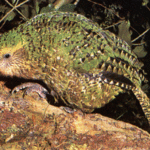Environment

Research in all manner of renewable energy technologies abounds. There’s tidal energy, underwater turbines, biological fuel cells, cow poop power. You name it someone’s probably having a go at it. Now researchers at the New Jersey Institute of Technology have come up with the kind of power source that is reminiscent of the Star Trek materializer – solar cells that spew out of an inkjet printer. It’s so simple, anyone can do it.
No more bulky, unsightly roof-top panels. No more taking out a second mortgage to do the right thing and be off the grid. Nope, you just slide in the flexible ‘paper…

One of the strangest and most endangered birds in the world, the kakapo, is being brought back from the brink of extinction with the help of scientists from the University of Glasgow.
The largest of all parrot species, flightless, nocturnal and plant-eating, the kakapo used to be found all over New Zealand. But ecological changes, habitat clearance and the introduction of predatory mammals combined to cause a catastrophic decline in numbers to only 51 in 1995.
Another factor in their near extinction is that kakapo breed infrequently. This is because they rear their young on the fruits of…

With all the talk of contaminated food pouring in from China and elsewhere, I have to wonder how safe our food supply really is. Let’s face it! It’s not just food coming from outside our borders that contain things not normally considered edible. There’s mercury and Prozac (yes Prozac) in our fish; hormones in our meat. And what about that old adage, an apple a day keeps the doctor away? Is it really healthy to eat all those apples? We’re not just eating apple with our apples, you know, but a whole array of pesticides and heaven knows what else.
I hate to be a neurotic alarmist about…

Researchers from Wildlife Conservation Society and India’s Nature Conservation Foundation have developed a unique “photographic capture-recapture” survey method that identifies individual male elephants, specifically by the shape and size of their tusks, ears, and other features. This in turn can be used to monitor their survival rates and movement.
“Unlike African elephants where both males and females have tusks, only male Asian elephants have valuable tusks, so they are specifically targeted by poachers,” said WCS researcher Varun Goswami, the study’s lead author. “In light of this fact,…

It may not seem intuitive that virtual reality can impact the real world environment but it's been shown to have a great deal of leverage in the UK, namely as a principal mechanism for stimulating support for wind farms.
SEE3D, part of the University of Wales, has worked with renewable energy company West Coast Energy to develop visualization software that will help fast track wind farm planning approvals. The new technology is being used in public consultations and as an inherent element in the planning approval process which allows local residents and councillors to tour proposed plans…

Cutting and burning tropical forests releases the atmospheric carbon they store, contributing significantly to global climate change. The "high forest cover and low rates of deforestation" (HFLD) countries contain 20 percent of Earth’s remaining tropical forest, including some of the richest ecosystems.
But 11 countries that have avoided widespread destruction of their tropical forest are at risk of being left out of the emerging carbon market intended to promote rainforest conservation to combat climate change.
A study published Tuesday warns that the HFLD nations could become the most…

Scientists from the Desert Research Institute (DRI) and their collaborators have determined that Northern Hemisphere industrial pollution resulted in a seven-fold increase in black carbon (soot) in Arctic snow during the late 19th and early 20th centuries, according to new research into the impact of black carbon on Arctic climate forcing.
The study in the August 9th online edition of Science magazine was led by Drs. Joe McConnell and Ross Edwards – two ice core scientists from DRI – who used a new method for measuring soot in snow and ice to evaluate historical changes in soot concentrations…

A new regional study shows that land-use policies in Peru have been key to tempering rain forest degradation and destruction in that country. Scientists at the Carnegie Institution’s Department of Global Ecology led an international effort to analyze seven years of high-resolution satellite data covering most (79%) of the Peruvian Amazon for their findings. The work is published in the August 9, 2007, on-line edition of Science Express.
The scientists found that the government’s program of designating specific regions for legal logging, combined with protection of other forests, and the…
A new WWF study tracking pygmy elephants by satellite shows that the remaining herds of these endangered elephants, which live only on the island of Borneo, are under threat from forest fragmentation and loss of habitat.
Borneo pygmy elephants depend for their survival on forests situated on flat, low lands and in river valleys, the study found. Unfortunately, it is also the type of terrain preferred for commercial plantations. Over the past four decades, 40 percent of the forest cover of the Malaysian State of Sabah, on the northeast of the Island of Borneo – where most of pygmy elephants…

Traditional plow-based agricultural methods and the need to feed a rapidly growing world population are combining to deplete the Earth's soil supply, a new study confirms.
In fact, long-established practices appear to increase soil erosion to the point that it is not offset by soil creation, said David Montgomery, a University of Washington professor of Earth and space sciences.
No-till agriculture, in which crop stubble is mixed with the top layer of soil using a method called disking, is far more sustainable, he said.
"Soil loss through conventional agriculture is in a range of 10 to 100…